Probability-Based Propagation Characteristics from Meteorological to Hydrological Drought and Their Dynamics in the Wei River Basin, China
Abstract
:1. Introduction
2. Study Area and Data
2.1. Study Area
2.2. Data
3. Methods
3.1. Standardized Precipitation Index (SPI) and Standardized Runoff Index (SRI)
3.2. A Quantification Model for Meteorological–Hydrological Drought Propagation Time
3.2.1. Copula Functions
3.2.2. Optimization of Joint Distribution Functions
3.2.3. Estimation of PT and Propagation Threshold
3.3. Random Forest (RF)
4. Results and Discussion
4.1. PT from Meteorological Drought to Hydrological Drought under Different Scenarios
4.2. Determination of Propagation Threshold
4.3. Dynamic Changes in Propagation Time
4.4. Analysis of Driving Forces for the PT from Meteorological Drought to Hydrological Drought
4.4.1. Simulation Results of the PT Based on Random Forest Model
4.4.2. Driving Force Analysis
4.5. Limitations and Prospects
- (1)
- When calculating the propagation threshold of drought, this paper chose 0.7 as the boundary of the propagation probability. Although for sequences with a length of thousands, 0.7 is already a high probability of occurrence, there is still a lack of theoretical support for the choice of data. In future research, some discussion can be carried out in this direction to determine a more convincing boundary.
- (2)
- In the attribution analysis, the selected driving factors may not be comprehensive enough, and some interactions between driving factors may be overlooked. Subsequent research can further expand the data to make the driving force analysis results more comprehensive and objective.
5. Conclusions
- (1)
- Under the same level, as the level of hydrological drought increased, the occurrence probability of hydrological drought correspondingly decreased; within the same level of hydrological drought, as the level of meteorological drought increased, the occurrence probability of hydrological drought correspondingly increased. The PT showed a distribution of being faster during the hot months (June–September) and slower during the cold months (December to March of the following year).
- (2)
- In the WRB, the PTs for spring, summer, autumn, and winter were within 9, 4, 7, and 16 ten-day periods, respectively; in the JRB, they were within 16, 3, 7, and 23 ten-day periods; and in the MWRB, they were within 20, 6, 5, and 21 ten-day periods. At the same time, under the same level of hydrological drought, as the level of meteorological drought increased, the PT shortened. The propagation thresholds from meteorological to hydrological drought for the WRB, JRB, and MWRB were −0.69, −0.81, and −0.78, respectively.
- (3)
- In the dynamic changes in PT, the WRB showed a non-significant decreasing trend; the PTs of different levels of drought in the JRB and the MWRB both significantly increased, passing the 95% confidence level test.
- (4)
- In the analysis of driving forces for the PT from meteorological to hydrological drought, during spring, summer, and winter, it was primarily the meteorological factors that had a more significant impact on the PT in the study basin. In autumn, for the Jing River Basin and the middle reaches of the Wei River, the underlying surface conditions had a greater impact on the PT.
Author Contributions
Funding
Data Availability Statement
Conflicts of Interest
References
- Keyantash, J.; Dracup, J.A. The Quantification of Drought: An Evaluation of Drought Indices. Bull. Am. Meteorol. Soc. 2002, 83, 1167–1180. [Google Scholar] [CrossRef]
- Zhang, D.-D.; Yan, D.; Lu, F.; Wang, Y.; Feng, J. Copula-based risk assessment of drought in Yunnan province, China. Nat. Hazards 2015, 75, 2199–2220. [Google Scholar] [CrossRef]
- Fang, W.; Huang, S.; Huang, Q.; Huang, G.; Wang, H.; Leng, G.; Wang, L.; Guo, Y. Probabilistic assessment of remote sensing-based terrestrial vegetation vulnerability to drought stress of the Loess Plateau in China. Remote Sens. Environ. 2019, 232, 111290. [Google Scholar] [CrossRef]
- Zhang, Q.; Yao, Y.; Li, Y.; Huang, J.; Ma, Z.; Wang, Z.; Wang, S.; Wang, Y.; Zhang, Y. Causes and Changes of Drought in China: Research Progress and Prospects. J. Meteorol. Res. 2020, 34, 460–481. [Google Scholar] [CrossRef]
- Xu, Y.; Zhu, X.; Cheng, X.; Gun, Z.; Lin, J.; Zhao, J.; Yao, L.; Zhou, C. Drought assessment of China in 2002–2017 based on a comprehensive drought index. Agric. For. Meteorol. 2022, 319, 108922. [Google Scholar] [CrossRef]
- Kiem, A.S.; Johnson, F.; Westra, S.; van Dijk, A.; Evans, J.P.; O’Donnell, A.; Rouillard, A.; Barr, C.; Tyler, J.; Thyer, M.; et al. Natural hazards in Australia: Droughts. Clim. Chang. 2016, 139, 37–54. [Google Scholar] [CrossRef]
- Sun, P.; Ma, Z.; Zhang, Q.; Singh, V.P.; Xu, C.-Y. Modified drought severity index: Model improvement and its application in drought monitoring in China. J. Hydrol. 2022, 612, 128097. [Google Scholar] [CrossRef]
- Wang, T.; Tu, X.; Singh, V.P.; Chen, X.; Lin, K. Global data assessment and analysis of drought characteristics based on CMIP6. J. Hydrol. 2021, 596, 126091. [Google Scholar] [CrossRef]
- Schwalm, C.R.; Anderegg, W.R.L.; Michalak, A.M.; Fisher, J.B.; Biondi, F.; Koch, G.; Litvak, M.; Ogle, K.; Shaw, J.D.; Wolf, A.; et al. Global patterns of drought recovery. Nature 2017, 548, 202–205. [Google Scholar] [CrossRef]
- Touma, D.; Ashfaq, M.; Nayak, M.A.; Kao, S.-C.; Diffenbaugh, N.S. A multi-model and multi-index evaluation of drought characteristics in the 21st century. J. Hydrol. 2015, 526, 196–207. [Google Scholar] [CrossRef]
- Wilhite, D. Drought as a Natural Hazard: Concepts and Definitions. In Drought: A Global Assessment; Routledge: London, UK, 2000; Volume 1, pp. 3–18. [Google Scholar]
- Su, B.; Huang, J.; Fischer, T.; Wang, Y.; Kundzewicz, Z.W.; Zhai, J.; Sun, H.; Wang, A.; Zeng, X.; Wang, G.; et al. Drought losses in China might double between the 1.5 °C and 2.0 °C warming. Proc. Natl. Acad. Sci. USA 2018, 115, 10600–10605. [Google Scholar] [CrossRef] [PubMed]
- Lesk, C.; Rowhani, P.; Ramankutty, N. Influence of extreme weather disasters on global crop production. Nature 2016, 529, 84–87. [Google Scholar] [CrossRef]
- Zhou, K.; Wang, Y.; Chang, J.; Zhou, S.; Guo, A. Spatial and temporal evolution of drought characteristics across the Yellow River basin. Ecol. Indic. 2021, 131, 108207. [Google Scholar] [CrossRef]
- Wang, F.; Wang, Z.; Yang, H.; Di, D.; Zhao, Y.; Liang, Q.; Hussain, Z. Comprehensive evaluation of hydrological drought and its relationships with meteorological drought in the Yellow River basin, China. J. Hydrol. 2020, 584, 124751. [Google Scholar] [CrossRef]
- Deng, H.; Yin, Y.; Zong, X.; Yin, M. Future drought risks in the Yellow River Basin and suggestions for targeted response. Int. J. Disaster Risk Reduct. 2023, 93, 103764. [Google Scholar] [CrossRef]
- Zhao, J.; Zhang, Q.; Zhu, X.; Shen, Z.; Yu, H. Drought risk assessment in China: Evaluation framework and influencing factors. Geogr. Sustain. 2020, 1, 220–228. [Google Scholar] [CrossRef]
- Sun, H.; Di, Z.; Qin, P.; Zhang, S.; Lang, Y. Spatio-temporal variation and dynamic risk assessment of drought and flood disaster (DFD) in China. Int. J. Disaster Risk Reduct. 2024, 100, 104140. [Google Scholar] [CrossRef]
- Wang, Z.; Huang, S.; Mu, Z.; Leng, G.; Duan, W.; Ling, H.; Xu, J.; Zheng, X.; Li, P.; Li, Z.; et al. Relative humidity and solar radiation exacerbate snow drought risk in the headstreams of the Tarim River. Atmos. Res. 2024, 297, 107091. [Google Scholar] [CrossRef]
- Chang, J.; Li, Y.; Ren, Y.; Wang, Y. Assessment of precipitation and drought variability in the Weihe River Basin, China. Arab. J. Geosci. 2016, 9, 633. [Google Scholar] [CrossRef]
- Fan, J.; Xu, F.; Sun, X.; Dong, W.; Ma, X.; Liu, G.; Cheng, Y.; Wang, H. Construction and Application of Hydrometeorological Comprehensive Drought Index in Weihe River. Atmosphere 2022, 13, 610. [Google Scholar] [CrossRef]
- Mishra, A.K.; Singh, V.P. A review of drought concepts. J. Hydrol. 2010, 391, 202–216. [Google Scholar] [CrossRef]
- Hao, Z.; Singh, V.P. Drought characterization from a multivariate perspective: A review. J. Hydrol. 2015, 527, 668–678. [Google Scholar] [CrossRef]
- Wilhite, D.; Glantz, M. Understanding: The Drought Phenomenon: The Role of Definitions. Water Int. 1985, 10, 111–120. [Google Scholar] [CrossRef]
- Hao, C.; Zhang, J.; Yao, F. Combination of multi-sensor remote sensing data for drought monitoring over Southwest China. Int. J. Appl. Earth Obs. Geoinf. 2015, 35, 270–283. [Google Scholar] [CrossRef]
- Zhang, Y.; Hao, Z.; Feng, S.; Zhang, X.; Xu, Y.; Hao, F. Agricultural drought prediction in China based on drought propagation and large-scale drivers. Agric. Water Manag. 2021, 255, 107028. [Google Scholar] [CrossRef]
- Yuan, X.; Zhang, M.; Wang, L.; Zhou, T. Understanding and seasonal forecasting of hydrological drought in the Anthropocene. Hydrol. Earth Syst. Sci. 2017, 21, 5477–5492. [Google Scholar] [CrossRef]
- Ding, Y.; Xu, J.; Wang, X.; Cai, H.; Zhou, Z.; Sun, Y.; Shi, H. Propagation of meteorological to hydrological drought for different climate regions in China. J. Environ. Manag. 2021, 283, 111980. [Google Scholar] [CrossRef] [PubMed]
- Wang, W.; Ertsen, M.W.; Svoboda, M.D.; Hafeez, M. Propagation of Drought: From Meteorological Drought to Agricultural and Hydrological Drought. Adv. Meteorol. 2016, 2016, 6547209. [Google Scholar] [CrossRef]
- Wang, F.; Lai, H.; Li, Y.; Feng, K.; Tian, Q.; Guo, W.; Zhang, W.; Di, D.; Yang, H. Dynamic variations of terrestrial ecological drought and propagation analysis with meteorological drought across the mainland China. Sci. Total Environ. 2023, 896, 165314. [Google Scholar] [CrossRef]
- Wei, X.; Huang, S.; Li, J.; Huang, Q.; Leng, G.; Liu, D.; Guo, W.; Zheng, X.; Bai, Q. The negative-positive feedback transition thresholds of meteorological drought in response to agricultural drought and their dynamics. Sci. Total Environ. 2024, 906, 167817. [Google Scholar] [CrossRef] [PubMed]
- Mehran, A.; Mazdiyasni, O.; Aghakouchak, A. A hybrid framework for assessing socioeconomic drought: Linking climate variability, local resilience, and demand. J. Geophys. Res. Atmos. 2015, 120, 7520–7533. [Google Scholar] [CrossRef]
- Hasan, H.H.; Mohd Razali, S.F.; Muhammad, N.S.; Ahmad, A. Research Trends of Hydrological Drought: A Systematic Review. Water 2019, 11, 2252. [Google Scholar] [CrossRef]
- Wanders, N.; Wada, Y. Human and climate impacts on the 21st century hydrological drought. J. Hydrol. 2015, 526, 208–220. [Google Scholar] [CrossRef]
- Huang, S.; Li, P.; Huang, Q.; Leng, G.; Hou, B.; Ma, L. The propagation from meteorological to hydrological drought and its potential influence factors. J. Hydrol. 2017, 547, 184–195. [Google Scholar] [CrossRef]
- Xu, Y.; Zhang, X.; Wang, X.; Hao, Z.; Singh, V.P.; Hao, F. Propagation from meteorological drought to hydrological drought under the impact of human activities: A case study in northern China. J. Hydrol. 2019, 579, 124147. [Google Scholar] [CrossRef]
- Shi, H.; Zhou, Z.; Liu, L.; Liu, S. A global perspective on propagation from meteorological drought to hydrological drought during 1902–2014. Atmos. Res. 2022, 280, 106441. [Google Scholar] [CrossRef]
- Apurv, T.; Sivapalan, M.; Cai, X. Understanding the Role of Climate Characteristics in Drought Propagation. Water Resour. Res. 2017, 53, 9304–9329. [Google Scholar] [CrossRef]
- Liu, S.; Huang, S.; Xie, Y.; Huang, Q.; Wang, H.; Leng, G. Assessing the non-stationarity of low flows and their scale-dependent relationships with climate and human forcing. Sci. Total Environ. 2019, 687, 244–256. [Google Scholar] [CrossRef]
- Li, R.; Chen, N.; Zhang, X.; Zeng, L.; Wang, X.; Tang, S.; Li, D.; Niyogi, D. Quantitative analysis of agricultural drought propagation process in the Yangtze River Basin by using cross wavelet analysis and spatial autocorrelation. Agric. For. Meteorol. 2020, 280, 107809. [Google Scholar] [CrossRef]
- Herrera-Estrada, J.E.; Satoh, Y.; Sheffield, J. Spatiotemporal dynamics of global drought. Geophys. Res. Lett. 2017, 44, 2254–2263. [Google Scholar] [CrossRef]
- Nie, M.; Huang, S.; Duan, W.; Leng, G.; Bai, G.; Wang, Z.; Huang, Q.; Fang, W.; Peng, J. Meteorological drought migration characteristics based on an improved spatiotemporal structure approach in the Loess Plateau of China. Sci. Total Environ. 2024, 912, 168813. [Google Scholar] [CrossRef]
- Van Lanen, H. Drought propagation through the hydrological cycle. In Water Resource Variability: Processes, Analyses and Impacts, Proceedings of the 5th FRIEND World Conference, Havana, Cuba, 27 November–1 December 2006; IAHS Press: Wallingford, UK, 2006; Volume 308, pp. 122–127. [Google Scholar]
- Wu, J.; Chen, X.; Yao, H.; Liu, Z.; Zhang, D. Hydrological Drought Instantaneous Propagation Speed Based on the Variable Motion Relationship of Speed-Time Process. Water Resour. Res. 2018, 54, 9549–9565. [Google Scholar] [CrossRef]
- Bevacqua, A.G.; Chaffe, P.L.B.; Chagas, V.B.P.; AghaKouchak, A. Spatial and temporal patterns of propagation from meteorological to hydrological droughts in Brazil. J. Hydrol. 2021, 603, 126902. [Google Scholar] [CrossRef]
- Ho, S.; Tian, L.; Disse, M.; Tuo, Y. A new approach to quantify propagation time from meteorological to hydrological drought. J. Hydrol. 2021, 603, 127056. [Google Scholar] [CrossRef]
- Geng, G.; Zhang, B.; Gu, Q.; He, Z.; Zheng, R. Drought propagation characteristics across China: Time, probability, and threshold. J. Hydrol. 2024, 631, 130805. [Google Scholar] [CrossRef]
- Li, Y.; Huang, S.; Wang, H.; Zheng, X.; Huang, Q.; Deng, M.; Peng, J. High-resolution propagation time from meteorological to agricultural drought at multiple levels and spatiotemporal scales. Agric. Water Manag. 2022, 262, 107428. [Google Scholar] [CrossRef]
- Abbas, A.; Waseem, M.; Ullah, W.; Zhao, C.; Zhu, J. Spatiotemporal Analysis of Meteorological and Hydrological Droughts and Their Propagations. Water 2021, 13, 2237. [Google Scholar] [CrossRef]
- Ma, L.; Huang, Q.; Huang, S.; Liu, D.; Leng, G.; Wang, L.; Li, P. Propagation dynamics and causes of hydrological drought in response to meteorological drought at seasonal timescales. Hydrol. Res. 2021, 53, 193–205. [Google Scholar] [CrossRef]
- Wang, L.; Zhang, J.; Elmahdi, A.; Shu, Z.; Wu, Y.; Wang, G. Evolution characteristics and relationship of meteorological and hydrological droughts from 1961 to 2018 in Hanjiang River Basin, China. J. Water Clim. Chang. 2021, 13, 224–246. [Google Scholar] [CrossRef]
- Zhu, N.; Xu, J.; Zeng, G.; Cao, X. Spatiotemporal Response of Hydrological Drought to Meteorological Drought on Multi-Time Scales Concerning Endorheic Basin. Int. J. Environ. Res. Public Health 2021, 18, 9074. [Google Scholar] [CrossRef] [PubMed]
- Dai, M. Study on the Propagation Characteristics and Laws of Drought in Meteorology-Agriculture-Disaster Loss. Master’s Thesis, Xi’an University of Technology, Xi’an, China, 2021. [Google Scholar]
- Huang, S.; Liu, D.; Huang, Q.; Chen, Y. Contributions of climate variability and human activities to the variation of runoff in the Wei River Basin, China. Hydrol. Sci. J. 2016, 61, 1026–1039. [Google Scholar] [CrossRef]
- Zhao, P.; Lü, H.; Yang, H.; Wang, W.; Fu, G. Impacts of climate change on hydrological droughts at basin scale: A case study of the Weihe River Basin, China. Quat. Int. 2019, 513, 37–46. [Google Scholar] [CrossRef]
- Omer, A.; Ma, Z.; Zheng, Z.; Saleem, F. Natural and anthropogenic influences on the recent droughts in Yellow River Basin, China. Sci. Total Environ. 2020, 704, 135428. [Google Scholar] [CrossRef] [PubMed]
- Zhang, T.; Su, X.; Zhang, G.; Wu, H.; Wang, G.; Chu, J. Evaluation of the impacts of human activities on propagation from meteorological drought to hydrological drought in the Weihe River Basin, China. Sci. Total Environ. 2022, 819, 153030. [Google Scholar] [CrossRef] [PubMed]
- Wang, J.; Wang, W.; Cheng, H.; Wang, H.; Zhu, Y. Propagation from Meteorological to Hydrological Drought and Its Influencing Factors in the Huaihe River Basin. Water 2021, 13, 1985. [Google Scholar] [CrossRef]
- Zhou, Z.; Shi, H.; Fu, Q.; Ding, Y.; Li, T.; Wang, Y.; Liu, S. Characteristics of Propagation From Meteorological Drought to Hydrological Drought in the Pearl River Basin. J. Geophys. Res. Atmos. 2021, 126, e2020JD033959. [Google Scholar] [CrossRef]
- Eckhardt, K. Technical Note: Analytical sensitivity analysis of a two parameter recursive digital baseflow separation filter. Hydrol. Earth Syst. Sci. 2012, 16, 451–455. [Google Scholar] [CrossRef]
- McKee, T.B.; Doesken, N.J.; Kliest, J. The Relationship of Drought Frequency and Duration to Time Scales. In Proceedings of the 8th Conference on Applied Climatology, Anaheim, CA, USA, 17–22 January 1993; pp. 179–184. [Google Scholar]
- Wang, Y.; Chen, X.; Chen, Y.; Liu, M.; Gao, L. Flood/drought event identification using an effective indicator based on the correlations between multiple time scales of the Standardized Precipitation Index and river discharge. Theor. Appl. Clim. 2017, 128, 159–168. [Google Scholar] [CrossRef]
- Li, J.; Wang, Z.; Wu, X.; Xu, C.-Y.; Guo, S.; Chen, X. Toward Monitoring Short-Term Droughts Using a Novel Daily-Scale, Standardized Antecedent Precipitation Evapotranspiration Index. J. Hydrometeorol. 2020, 21, 891–908. [Google Scholar] [CrossRef]
- Sadeghi, S.H.; Hazbavi, Z. Spatiotemporal variation of watershed health propensity through reliability-resilience-vulnerability based drought index (case study: Shazand Watershed in Iran). Sci. Total Environ. 2017, 587–588, 168–176. [Google Scholar] [CrossRef]
- Jiao, W.; Wang, L.; Novick, K.A.; Chang, Q. A new station-enabled multi-sensor integrated index for drought monitoring. J. Hydrol. 2019, 574, 169–180. [Google Scholar] [CrossRef]
- Shukla, S.; Wood, A.W. Use of a standardized runoff index for characterizing hydrologic drought. Geophys. Res. Lett. 2008, 35. [Google Scholar] [CrossRef]
- Guo, Y.; Huang, S.; Huang, Q.; Leng, G.; Fang, W.; Wang, L.; Wang, H. Propagation thresholds of meteorological drought for triggering hydrological drought at various levels. Sci. Total Environ. 2020, 712, 136502. [Google Scholar] [CrossRef] [PubMed]
- Sklar, M. Fonctions de Répartition à n Dimensions et Leurs Marges; l’Institut Statistique de l’Université de Paris: Paris, France, 1959; Volume 8, pp. 229–231. [Google Scholar]
- Salvadori, G.; Michele, C.D. Frequency analysis via copulas: Theoretical aspects and applications to hydrological events. Water Resour. Res. 2004, 40. [Google Scholar] [CrossRef]
- Breiman, L. Random Forests. Mach. Learn. 2001, 45, 5–32. [Google Scholar] [CrossRef]
- Burn, D.H.; Hag Elnur, M.A. Detection of hydrologic trends and variability. J. Hydrol. 2002, 255, 107–122. [Google Scholar] [CrossRef]
- Umar, D.u.A.; Ramli, M.F.; Aris, A.Z.; Jamil, N.R.; Aderemi, A.A. Evidence of climate variability from rainfall and temperature fluctuations in semi-arid region of the tropics. Atmos. Res. 2019, 224, 52–64. [Google Scholar] [CrossRef]
- Zhao, P.; Xie, B.; Huang, X.; Qu, B. The dynamic change of propagation from meteorological drought to hydrological drought at the basin scale: A case study from the Weihe River Basin, China. Front. Environ. Sci. 2022, 10, 1054975. [Google Scholar] [CrossRef]

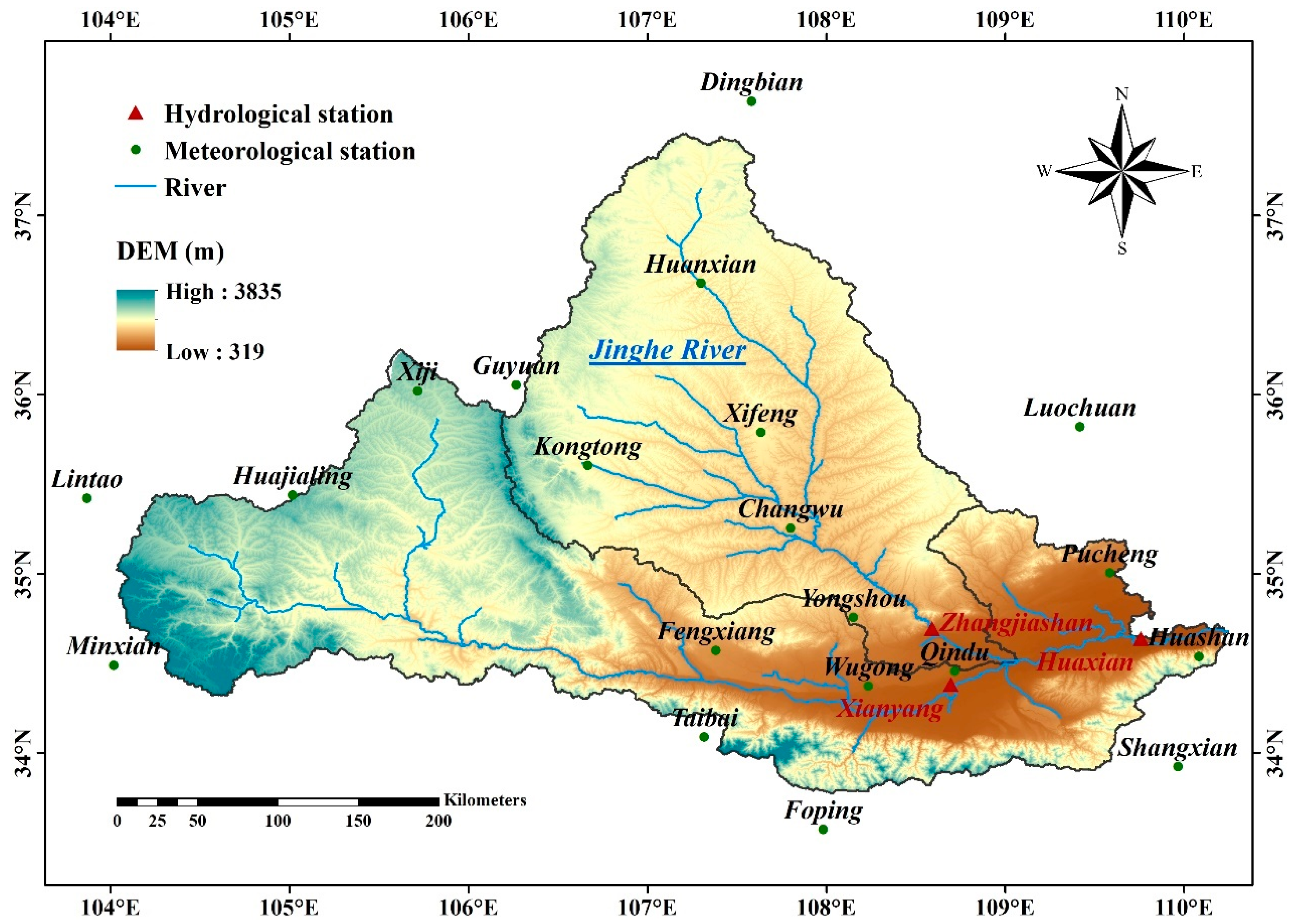
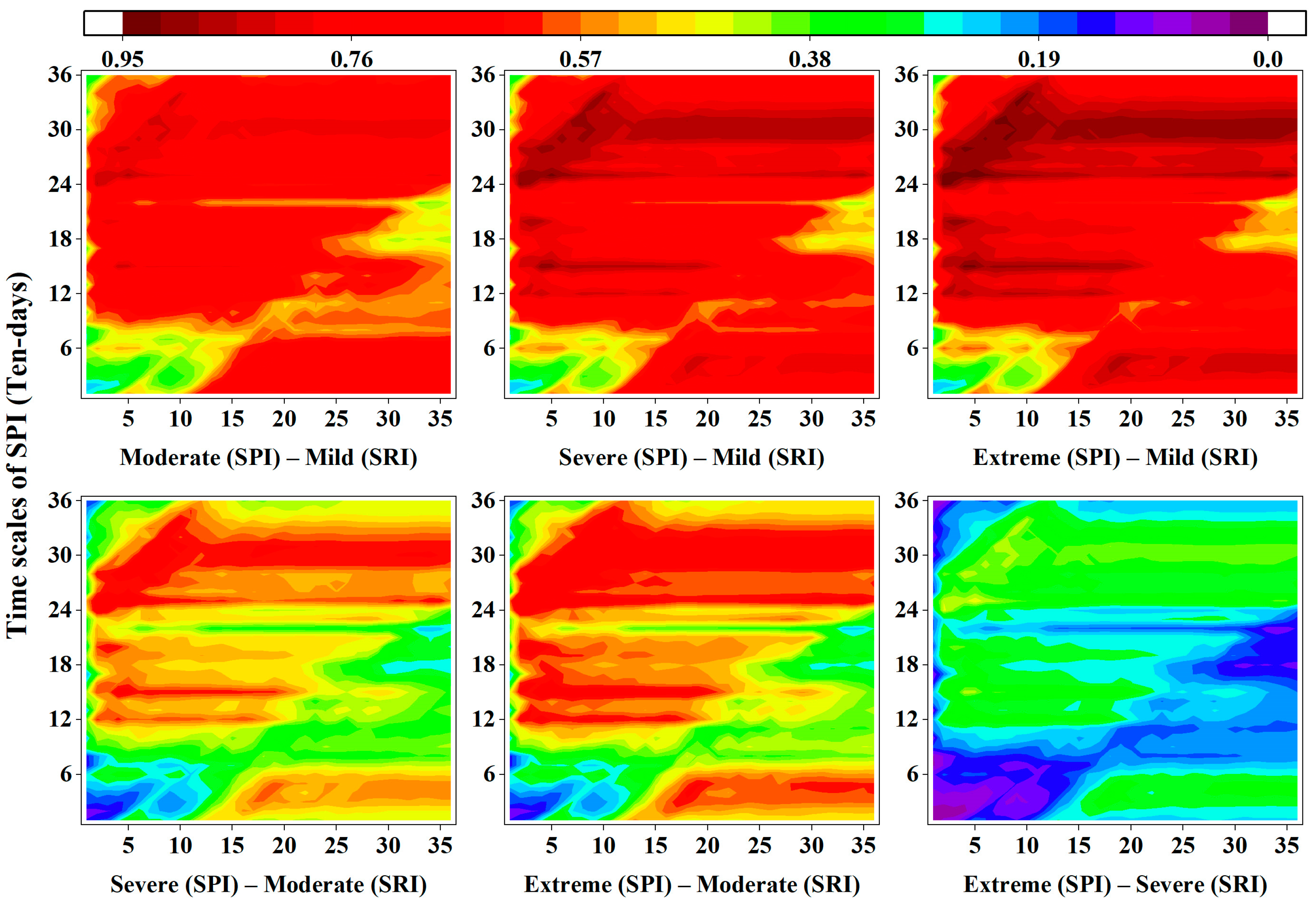





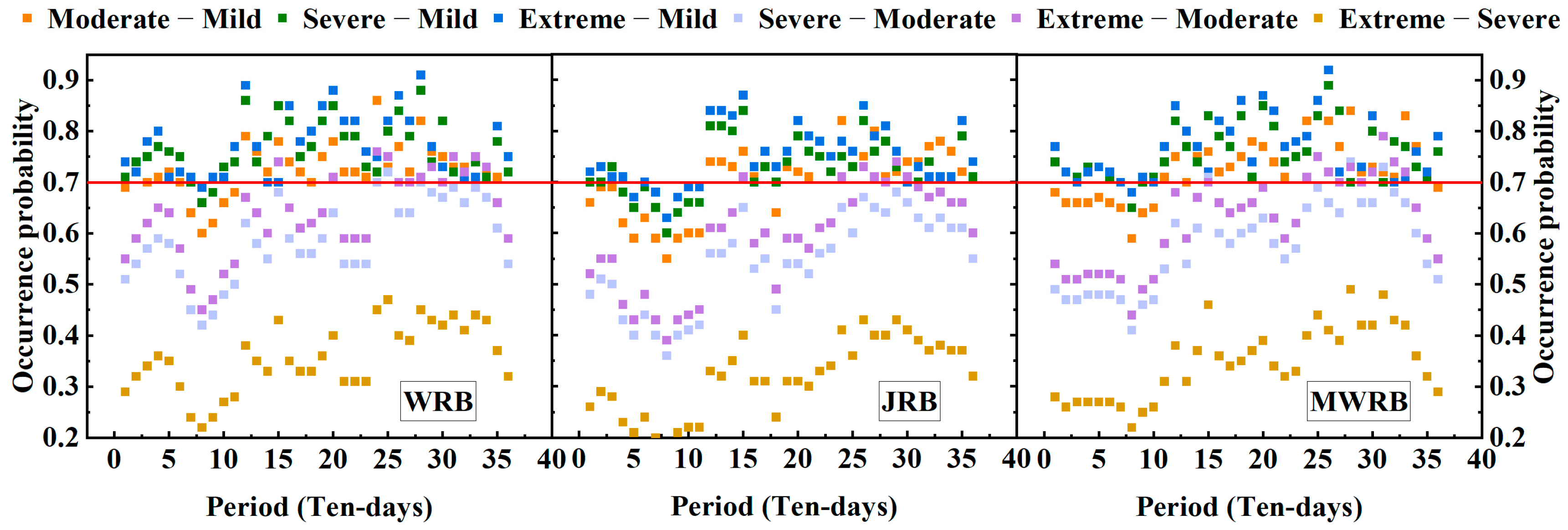

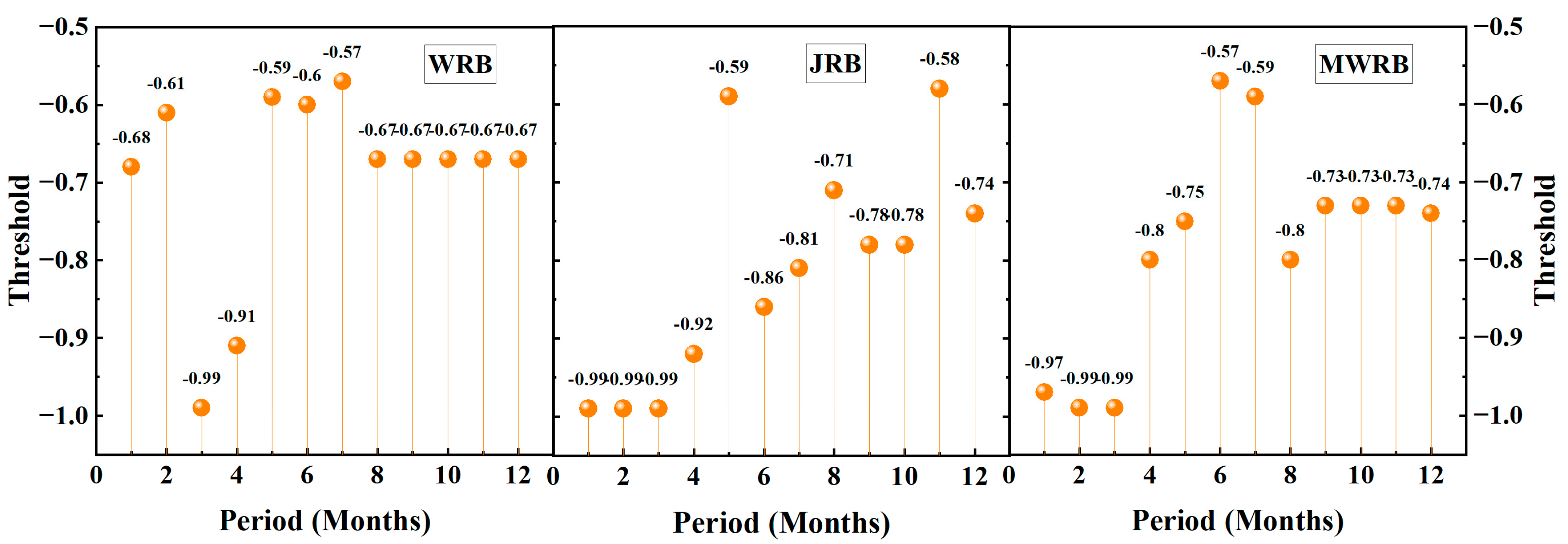
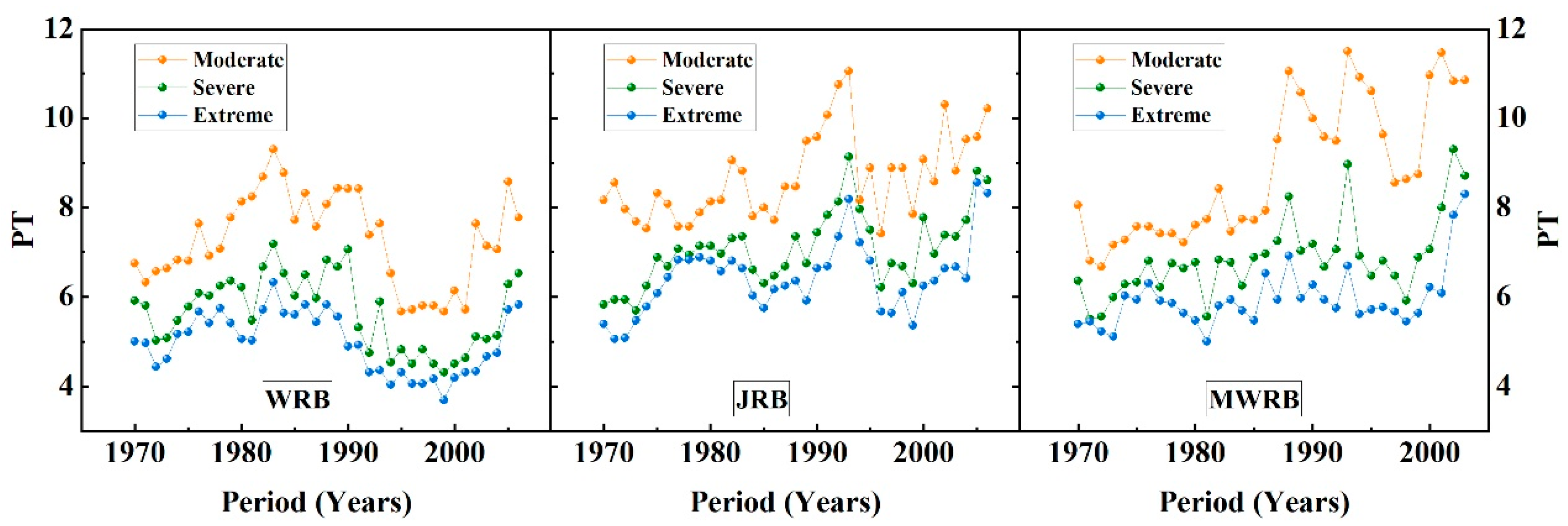
| Level | Classification | SPI Value | SRI Value |
|---|---|---|---|
| 1 | Mild drought | −1 < SPI ≤ −0.5 | −1 < SRI ≤ −0.5 |
| 2 | Moderate drought | −1.5 < SPI ≤ −1.0 | −1.5 < SRI ≤ −1.0 |
| 3 | Severe drought | −2.0 < SPI ≤ −1.5 | −2.0 < SRI ≤ −1.5 |
| 4 | Extreme drought | SPI ≤ −2.0 | SRI ≤ −2.0 |
| Meteorological Drought Level | Propensity Rate | M-K Value | Trend | |
|---|---|---|---|---|
| WRB | Moderate | −0.01 | −0.18 | ↓ |
| Severe | −0.03 | −1.46 | ↓ | |
| Extreme | −0.02 | −1.78 | ↓ | |
| JRB | Moderate | 0.05 | 3.58 | ↑ ** |
| Severe | 0.05 | 3.90 | ↑ ** | |
| Extreme | 0.03 | 2.01 | ↑ * | |
| MWRB | Moderate | 0.12 | 5.26 | ↑ ** |
| Severe | 0.05 | 3.99 | ↑ ** | |
| Extreme | 0.03 | 2.06 | ↑ * | |
| Meteorological Drought Level | Spring | Summer | Autumn | Winter | |||||||||
|---|---|---|---|---|---|---|---|---|---|---|---|---|---|
| WRB | JRB | MWRB | WRB | JRB | MWRB | WRB | JRB | MWRB | WRB | JRB | MWRB | ||
| Moderate | Propensity | −0.08 | 0.03 | 0.19 | 0.04 | 0.04 | 0.00 | 0.00 | 0.03 | 0.03 | −0.01 | 0.09 | 0.03 |
| M-K value | −0.81 | 1.07 | 2.59 | 1.99 | 1.96 | 0.28 | −1.07 | 2.51 | 2.21 | −0.03 | 2.80 | 4.85 | |
| Trend | ↓ | ↑ | ↑ ** | ↑ * | ↑ * | ↑ | ↓ | ↑ * | ↑ * | ↓ | ↑ ** | ↑ ** | |
| Severe | Propensity | −0.10 | 0.07 | 0.06 | 0.03 | 0.01 | 0.01 | −0.02 | 0.00 | 0.00 | −0.02 | 0.10 | 0.15 |
| M-K value | −2.64 | 1.46 | −0.07 | 3.95 | 2.35 | 1.08 | −5.21 | −1.15 | −1.41 | −1.31 | 3.35 | 4.43 | |
| Trend | ↓ ** | ↑ | ↓ | ↑ ** | ↑ * | ↑ | ↓ ** | ↓ | ↓ | ↓ | ↑ ** | ↑ ** | |
| Extreme | Propensity | −0.10 | 0.06 | 0.00 | 0.03 | 0.01 | 0.01 | −0.02 | −0.01 | 0.00 | −0.01 | 0.07 | 0.13 |
| M-K value | −3.51 | 0.99 | −2.21 | 4.03 | 2.33 | 1.23 | −3.77 | −3.01 | −1.68 | −1.12 | 3.43 | 4.37 | |
| Trend | ↓ ** | ↑ | ↓ * | ↑ ** | ↑ * | ↑ | ↓ ** | ↓ ** | ↓ * | ↓ | ↑ ** | ↑ ** | |
| Meteorological Drought Level | Spring | Summer | Autumn | Winter | |||||
|---|---|---|---|---|---|---|---|---|---|
| NSE | R2 | NSE | R2 | NSE | R2 | NSE | R2 | ||
| Moderate | WRB | 0.89 | 0.96 | 0.78 | 0.94 | 0.83 | 0.95 | 0.82 | 0.95 |
| JRB | 0.86 | 0.95 | 0.82 | 0.93 | 0.85 | 0.95 | 0.78 | 0.90 | |
| MWRB | 0.87 | 0.96 | 0.78 | 0.94 | 0.83 | 0.94 | 0.91 | 0.96 | |
| Severe | WRB | 0.89 | 0.96 | 0.78 | 0.91 | 0.82 | 0.94 | 0.81 | 0.94 |
| JRB | 0.88 | 0.96 | 0.82 | 0.94 | 0.74 | 0.95 | 0.81 | 0.92 | |
| MWRB | 0.87 | 0.96 | 0.80 | 0.95 | 0.73 | 0.90 | 0.88 | 0.95 | |
| Extreme | WRB | 0.92 | 0.96 | 0.75 | 0.91 | 0.77 | 0.95 | 0.81 | 0.93 |
| JRB | 0.91 | 0.97 | 0.84 | 0.95 | 0.77 | 0.93 | 0.78 | 0.91 | |
| MWRB | 0.84 | 0.95 | 0.80 | 0.97 | 0.77 | 0.92 | 0.91 | 0.96 | |
| Seasons | Basin | Precipitation | VPD | Soil Moisture | Base Flow |
|---|---|---|---|---|---|
| Spring | WRB | 7.26 | 5.61 | 3.24 | 6.94 |
| JRB | 2.98 | 6.33 | 2.06 | 2.79 | |
| MWRB | 4.67 | 7.81 | 3.55 | 1.43 | |
| Summer | WRB | 0.11 | 3.84 | 0.41 | 6.29 |
| JRB | 0.73 | 8.22 | 2.06 | 2.84 | |
| MWRB | 3.75 | 3.31 | 0.77 | 7.02 | |
| Autumn | WRB | 3.19 | 4.33 | 2.67 | 5.16 |
| JRB | 2.95 | 5.24 | 1.83 | 5.85 | |
| MWRB | 2.44 | 4.19 | 0.71 | 4.78 | |
| Winter | WRB | 6.75 | 6.99 | 0.33 | 0.09 |
| JRB | 2.26 | 7.04 | 1.08 | 0.14 | |
| MWRB | 4.19 | 14.64 | 0.99 | 2.63 |
| Seasons | Basin | Precipitation | VPD | Soil Moisture | Base Flow |
|---|---|---|---|---|---|
| Spring | WRB | 7.04 | 5.24 | 0.79 | 3.87 |
| JRB | 7.67 | 10.37 | 0.12 | 2.59 | |
| MWRB | 3.88 | 6.86 | 0.79 | 1.43 | |
| Summer | WRB | 3.52 | 7.10 | 2.17 | 1.59 |
| JRB | 1.13 | 7.73 | 0.12 | 0.60 | |
| MWRB | 4.25 | 1.76 | 0.05 | 2.83 | |
| Autumn | WRB | 6.16 | 5.60 | 1.09 | 1.05 |
| JRB | 1.19 | 0.90 | 5.08 | 0.64 | |
| MWRB | 0.26 | 1.72 | 0.70 | 2.44 | |
| Winter | WRB | 7.33 | 5.95 | 0.15 | 0.29 |
| JRB | 3.41 | 10.43 | 0.74 | 0.52 | |
| MWRB | 4.19 | 14.64 | 0.99 | 2.63 |
| Seasons | Basin | Precipitation | VPD | Soil Moisture | Base Flow |
|---|---|---|---|---|---|
| Spring | WRB | 7.53 | 12.24 | 0.27 | 1.06 |
| JRB | 9.25 | 8.42 | 1.95 | 2.42 | |
| MWRB | 3.58 | 4.83 | 0.32 | 0.45 | |
| Summer | WRB | 1.84 | 7.01 | 0.66 | 2.21 |
| JRB | 0.44 | 8.92 | 0.74 | 0.69 | |
| MWRB | 3.35 | 2.31 | 0.51 | 3.79 | |
| Autumn | WRB | 3.07 | 4.60 | 1.43 | 0.30 |
| JRB | 2.12 | 3.25 | 0.07 | 0.09 | |
| MWRB | 2.07 | 0.45 | 3.11 | 1.42 | |
| Winter | WRB | 6.33 | 4.85 | 1.57 | 0.00 |
| JRB | 0.02 | 7.89 | 0.09 | 0.46 | |
| MWRB | 3.71 | 13.24 | 0.88 | 2.42 |
Disclaimer/Publisher’s Note: The statements, opinions and data contained in all publications are solely those of the individual author(s) and contributor(s) and not of MDPI and/or the editor(s). MDPI and/or the editor(s) disclaim responsibility for any injury to people or property resulting from any ideas, methods, instructions or products referred to in the content. |
© 2024 by the authors. Licensee MDPI, Basel, Switzerland. This article is an open access article distributed under the terms and conditions of the Creative Commons Attribution (CC BY) license (https://creativecommons.org/licenses/by/4.0/).
Share and Cite
Du, M.; Liu, Y.; Huang, S.; Zheng, H.; Huang, Q. Probability-Based Propagation Characteristics from Meteorological to Hydrological Drought and Their Dynamics in the Wei River Basin, China. Water 2024, 16, 1999. https://doi.org/10.3390/w16141999
Du M, Liu Y, Huang S, Zheng H, Huang Q. Probability-Based Propagation Characteristics from Meteorological to Hydrological Drought and Their Dynamics in the Wei River Basin, China. Water. 2024; 16(14):1999. https://doi.org/10.3390/w16141999
Chicago/Turabian StyleDu, Meng, Yongjia Liu, Shengzhi Huang, Hao Zheng, and Qiang Huang. 2024. "Probability-Based Propagation Characteristics from Meteorological to Hydrological Drought and Their Dynamics in the Wei River Basin, China" Water 16, no. 14: 1999. https://doi.org/10.3390/w16141999






